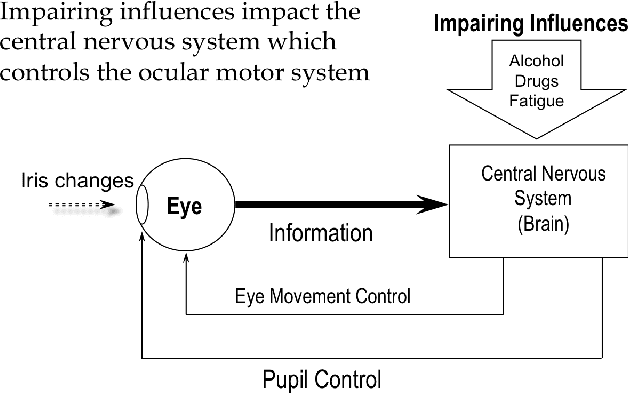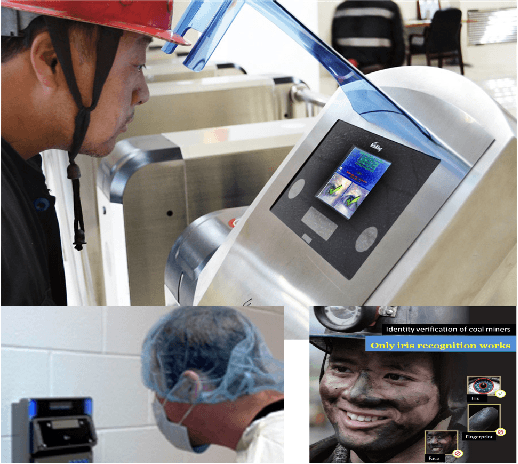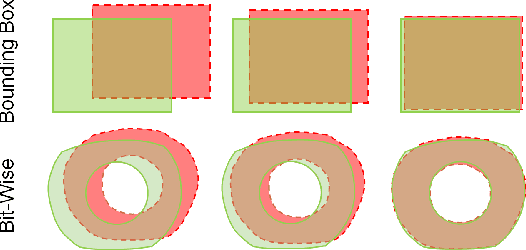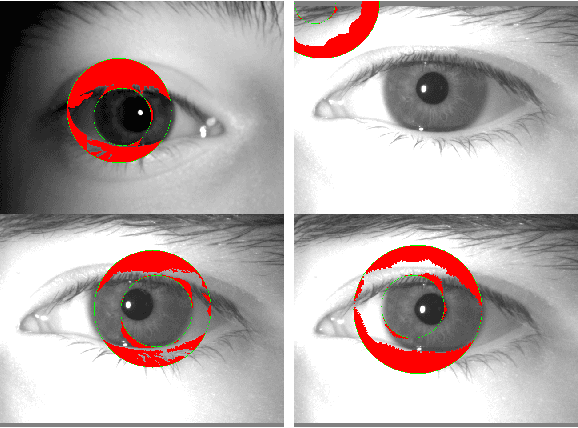Leonardo Causa
Towards an efficient Iris Recognition System on Embedded Devices
Oct 24, 2022Abstract:Iris Recognition (IR) is one of the market's most reliable and accurate biometric systems. Today, it is challenging to build NIR-capturing devices under the premise of hardware price reduction. Commercial NIR sensors are protected from modification. The process of building a new device is not trivial because it is required to start from scratch with the process of capturing images with quality, calibrating operational distances, and building lightweight software such as eyes/iris detectors and segmentation sub-systems. In light of such challenges, this work aims to develop and implement iris recognition software in an embedding system and calibrate NIR in a contactless binocular setup. We evaluate and contrast speed versus performance obtained with two embedded computers and infrared cameras. Further, a lightweight segmenter sub-system called "Unet_xxs" is proposed, which can be used for iris semantic segmentation under restricted memory resources.
Learning to Predict Fitness for Duty using Near Infrared Periocular Iris Images
Sep 04, 2022



Abstract:This research proposes a new database and method to detect the reduction of alertness conditions due to alcohol, drug consumption and sleepiness deprivation from Near-Infra-Red (NIR) periocular eye images. The study focuses on determining the effect of external factors on the Central Nervous System (CNS). The goal is to analyse how this impacts iris and pupil movement behaviours and if it is possible to classify these changes with a standard iris NIR capture device. This paper proposes a modified MobileNetV2 to classify iris NIR images taken from subjects under alcohol/drugs/sleepiness influences. The results show that the MobileNetV2-based classifier can detect the Unfit alertness condition from iris samples captured after alcohol and drug consumption robustly with a detection accuracy of 91.3% and 99.1%, respectively. The sleepiness condition is the most challenging with 72.4%. For two-class grouped images belonging to the Fit/Unfit classes, the model obtained an accuracy of 94.0% and 84.0%, respectively, using a smaller number of parameters than the standard Deep learning Network algorithm. This work is a step forward in biometric applications for developing an automatic system to classify "Fitness for Duty" and prevent accidents due to alcohol/drug consumption and sleepiness.
Semantic Segmentation of Periocular Near-Infra-Red Eye Images Under Alcohol Effects
Jun 30, 2021



Abstract:This paper proposes a new framework to detect, segment, and estimate the localization of the eyes from a periocular Near-Infra-Red iris image under alcohol consumption. The purpose of the system is to measure the fitness for duty. Fitness systems allow us to determine whether a person is physically or psychologically able to perform their tasks. Our framework is based on an object detector trained from scratch to detect both eyes from a single image. Then, two efficient networks were used for semantic segmentation; a Criss-Cross attention network and DenseNet10, with only 122,514 and 210,732 parameters, respectively. These networks can find the pupil, iris, and sclera. In the end, the binary output eye mask is used for pupil and iris diameter estimation with high precision. Five state-of-the-art algorithms were used for this purpose. A mixed proposal reached the best results. A second contribution is establishing an alcohol behavior curve to detect the alcohol presence utilizing a stream of images captured from an iris instance. Also, a manually labeled database with more than 20k images was created. Our best method obtains a mean Intersection-over-Union of 94.54% with DenseNet10 with only 210,732 parameters and an error of only 1-pixel on average.
 Add to Chrome
Add to Chrome Add to Firefox
Add to Firefox Add to Edge
Add to Edge